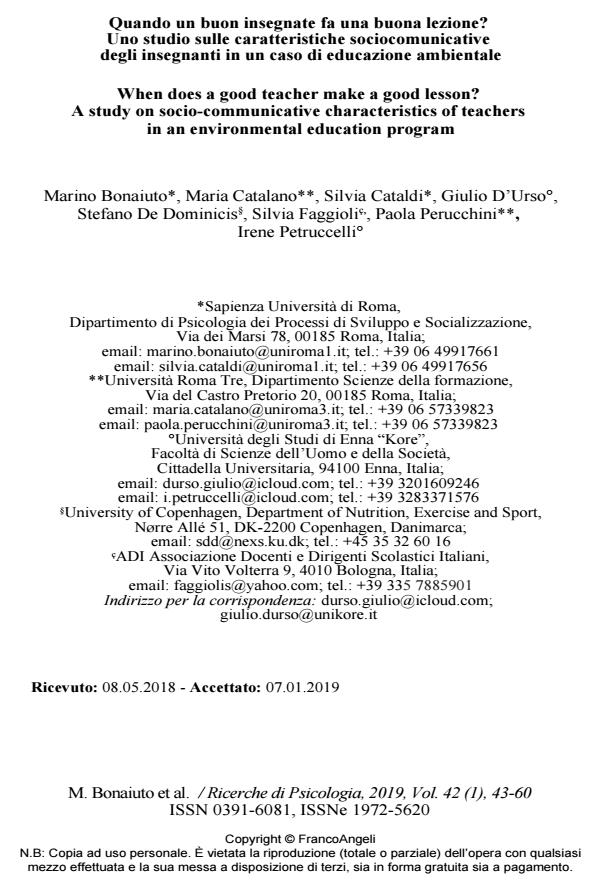When does a good teacher make a good lesson? A study on socio-communicative characteristics of teachers in an environmental education program
Journal title RICERCHE DI PSICOLOGIA
Author/s Marino Bonaiuto, Maria Catalano, Silvia Cataldi, Giulio D’Urso, Stefano De Dominicis, Silvia Faggioli, Paola Perucchini, Irene Petruccelli
Publishing Year 2019 Issue 2019/1
Language Italian Pages 18 P. 43-60 File size 219 KB
DOI 10.3280/RIP2019-001003
DOI is like a bar code for intellectual property: to have more infomation
click here
Below, you can see the article first page
If you want to buy this article in PDF format, you can do it, following the instructions to buy download credits

FrancoAngeli is member of Publishers International Linking Association, Inc (PILA), a not-for-profit association which run the CrossRef service enabling links to and from online scholarly content.
The present study aims to verify if and which didactic and interactive strate-gies implemented by teachers in the classroom, during their lessons, can be a fac-tor related to good teacher-student relationships, as well as a factor related to the development of satisfying relationships among peers. The participants in the study were 201 students. Lessons, conducted on ecological topic, were handled by 15 teachers in 3 different countries. In addition, 17 observers, suitably trained and coming from the different countries involved, attended the lessons. Lessons’ evaluation was carried out through a toolkit (Toolkit for lesson evaluation), which consists in three different forms related to the point of view of different participants: external observers, students and teachers. Students have completed two tools: the SGE Student Grid and the TEP-Q Etero Evaluation. Observers completed the SGE Observer Grid. The multiple regression analysis suggests that teachers’ explanation modality, perceived by the observers, positively predicts the good relationships between teachers and students. Furthermore, teacher’s ef-fective communication and teacher’s attention to the relationship predict good relationships among peers. Finally, the correlation analysis highlights how good relations between students are related with the use of active methodologies by the teacher.
Keywords: Teachers, peer relationships, quality of lesson
- Positive Youth Development and Being Bullied in Early Adolescence: A Sociocultural Analysis of National Cohort Data Giulio D’Urso, Jennifer Symonds, Ugo Pace, in The Journal of Early Adolescence /2021 pp.577
DOI: 10.1177/0272431620931199 - The relation between workload and personal well-being among university professors Francesco Pace, Giulio D’Urso, Carla Zappulla, Ugo Pace, in Current Psychology /2021 pp.3417
DOI: 10.1007/s12144-019-00294-x
Marino Bonaiuto, Maria Catalano, Silvia Cataldi, Giulio D’Urso, Stefano De Dominicis, Silvia Faggioli, Paola Perucchini, Irene Petruccelli, Quando un buon insegnate fa una buona lezione? Uno studio sulle caratteristiche sociocomunicative degli insegnanti in un caso di educazione ambientale in "RICERCHE DI PSICOLOGIA " 1/2019, pp 43-60, DOI: 10.3280/RIP2019-001003